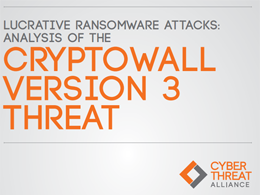
McAfee Labs Forecasts Growth in Mobile Ransomware and Security-Aware Attacks in 2014
McAfee Labs today released its annual 2014 PredictionsReport, analyzing 2013 trends through its proprietary McAfee Global Threat Intelligence (GTI) service to forecast the threat landscape for the coming year.
In 2014, McAfee Labs expects to see the rapidly growing mobile platform draw the lion’s share of threat innovation. Ransomware is expected to proliferate on mobile devices, as virtual currencies such as Bitcoin fuel the growth of ransomware across all platforms.
Attacks using advanced evasion techniques will come of age, with enhanced capabilities to identify and bypass some sandboxing and other local security measures. Social platforms will be used more aggressively to target the finances and personal information of consumers, and the intellectual property and trade secrets of business leaders.
“With target audiences so large, financing mechanisms so convenient, and cyber-talent so accessible, robust innovation in criminal technology and tactics will continue its surge forward in 2014,” said Vincent Weafer, senior vice president of McAfee Labs.
“The activity in mobile and social is representative of an increasing ‘black hat’ focus on the fastest growing and most digitally active consumer audiences, in which personal information is almost as attractive as banking passwords. The emergence and evolution of advanced evasion techniques represents a new enterprise security battlefront, where the hacker’s deep knowledge of architectures and common security tactics enable attacks that are very hard to uncover.”
McAfee Labs foresees the following trends in 2014:
1. Mobile malware will be the driver of growth in both technical innovation and the volume of attacks in the overall malware “market” in 2014. In the last two quarters reported, new PC malware growth was nearly flat, while appearances of new Android samples grew by 33%. With businesses and consumers continuing their shift to mobile, we expect to see ransomware aimed at mobile devices, attacks targeting near-field communications vulnerabilities, and attacks that corrupt valid apps to expropriate data without being detected.
2. Virtual currencies will fuel malicious ransomware attacks around the world. Although largely a positive development, virtual currencies provide cybercriminals the unregulated and anonymous payment infrastructure they need to collect money from their victims. Currencies such as Bitcoin will enable and accelerate new generations of ransomware such as the Cryptolocker threat of 2013.
3. In the spy vs. spy world of cybercrime and cyber warfare, criminal gangs and state actors will deploy new stealth attacks that will be harder than ever to identify and stop. There will be broad adoption of advanced evasion techniques, such as the use of sandbox-aware attacks that do not fully deploy unless they believe they are running directly on an unprotected device. Other attack technologies will include return-oriented programming attacks that cause legitimate applications to behave in malicious ways, self-deleting malware that covers its tracks after subverting a target, and advanced attacks on dedicated industrial control systems targeting public and private infrastructure.
4. “Social attacks” will be ubiquitous by the end of 2014. We expect to see more attacks that leverage social platform features to capture passwords or data about user contacts, location, or business activities. Such information can be used to target advertising or perpetrate virtual or real-world crimes. Either directly or through third parties, enterprises will increasingly use “reconnaissance attacks” to capture valuable user and organizational information to gain tactical and strategic advantages.
5. New PC and server attacks will target vulnerabilities above and below the operating system. In 2014, new PC attacks will exploit application vulnerabilities in HTML5, which allows websites to come alive with interaction, personalization, and rich capabilities for programmers. On the mobile platform, we expect to see attacks that will breach the browser’s “sandbox” and give attackers direct access to the device and its services. And cybercriminals will increasingly target vulnerabilities below the operating system in the storage stack and even the BIOS.
6. The evolving threat landscape will dictate adoption of big data security analytics to meet detection and performance requirements. In 2014, security vendors will continue to add new threat-reputation services and analytics tools that will enable them and their users to identify stealth and advanced persistent threats faster and more accurately than can be done today with basic “blacklisting” and “whitelisting” technologies.
7. Deployment of cloud-based corporate applications will create new attack surfaces that will be exploited by cybercriminals. Cybercriminals will look for more ways to exploit the ubiquitous hypervisors found in all data centers, the multitenant access and communications infrastructure implicit in cloud services, and management infrastructure used to provision and monitor large-scale cloud services. Because they lack sufficient leverage to demand security measures in line with their organizational needs, small businesses that purchase cloud-based services will continue to grapple with security risks unaddressed by cloud providers’ user agreements and operating procedures.
For a full copy of the 2014 Predictions Report from McAfee Labs, please visit: http://mcaf.ee/utjz4
About McAfee Labs
McAfee Labs is the world’s leading source for threat research, threat intelligence, and cybersecurity thought leadership. The McAfee Labs team of 500 researchers collects threat data from millions of sensors across key threat vectors—file, web, message, and network. It then performs cross-vector threat correlation analysis and delivers real-time threat intelligence to tightly integrated McAfee endpoint and network security products through its cloud-based McAfee Global Threat Intelligence service. McAfee Labs also develops core threat detection technologies—such as DeepSAFE, application profiling, and graylist management—that are incorporated into the broadest security product portfolio in the industry.
About McAfee
McAfee, a wholly owned subsidiary of Intel Corporation (NASDAQ: INTC), empowers businesses, the public sector, and home users to safely experience the benefits of the Internet. The company delivers proactive and proven security solutions and services for systems, networks, and mobile devices around the world. With its Security Connected strategy, innovative approach to hardware-enhanced security, and unique Global Threat Intelligence network, McAfee is relentlessly focused on keeping its customers safe.
McAfee: http://www.mcafee.com/
Related News





